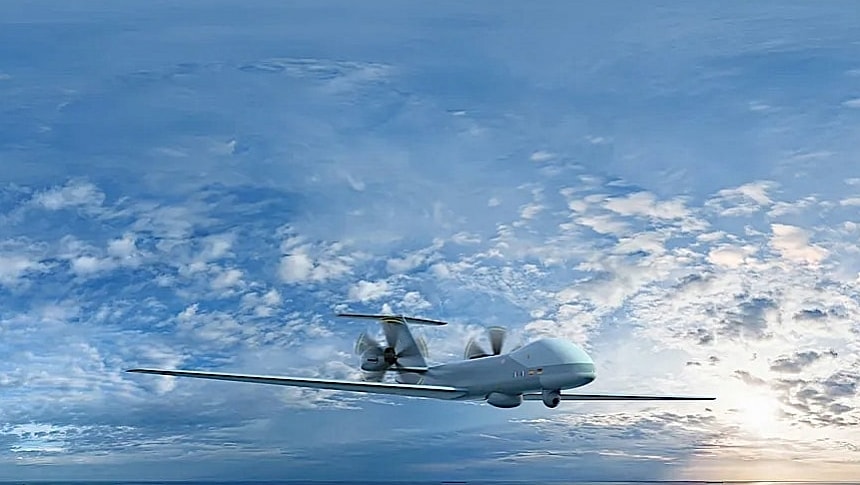Many of the world's militaries employ drones for various purposes, but regardless on where they are deployed on this planet, and by whom, the vast majority of the big, professional drones used for surveillance and strikes are made in the U.S.A. And Europe doesn't like that, so not long ago it set out to create something called the Eurodrone.
The Eurodrone program, which was announced about a year ago, is a collaborative effort between European aviation companies Airbus, Dassault, Safran, and Leonardo, and aims to deliver an uncrewed aerial platform that can be used for intelligence, surveillance, target acquisition, and reconnaissance (ISTAR) missions.
The Old Continent makes no secret of the fact it wants to "ensure European sovereignty and independence in this critical segment of unmanned long endurance ISTAR capability," especially given how it is there where the largest conflict between developed nations since World War II is raging.
In the time since the program was announced, work on it advanced greatly. So much so, in fact, that last week Airbus announced the Eurodrone completed its preliminary design review.
When it comes to aircraft, the preliminary design review is that point in a project's life when the parties involved have a look at the overall idea and determine if it has what it takes to move forward.
In the case of the Eurodrone, the review consisted of various assessments and evaluations, including wind tunnel testing of the overall design, but also a validation of a digital Eurodrone that's being developed at the same time. All these procedures, it seems, were successful, so the aircraft will now move one step closer to production, which is the critical design review.
The companies working on this, but also the countries that will first field the drone (France, Germany, Italy and Spain) want the first operational example in the sky by 2027, and fielding in the hands of the military in 2028. As far as we know, the prototype should be completed by the end of this year.
When ready for duty, the Eurodrone will be a sight to behold, even if we're talking about sheer size alone. With a wingspan of 85 feet (26 meters) and a height of 19 feet (six meters), the aircraft will be larger than one of America's most fearsome airborne weapons platforms, the mighty Warthog, the A-10 Thunderbolt II – that one has a wingspan of 57 feet (17 meters) and stands 14 feet (4.4 meters) high.
The drone will be powered by a pair of General Electric turboprop engines installed on the main fuselage (another thing the European project shares with the A-10), and should be capable of reaching a top speed of 310 mph (500 kph).
The aircraft will be capable of carrying a maximum payload of 5,000 pounds (2,300 kg) and can reach altitudes of 45,000 feet (almost 14 km straight up). The flightime of the drone is estimated at 40 hours.
Airbus wants the Eurodrone to "become one of the main pillars of any future combat air system" and be capable of operating in the same airspace as crewed aircraft. And that only means we still have a lot to learn about its capabilities. Naturally, we'll keep an eye out for more details.
The Old Continent makes no secret of the fact it wants to "ensure European sovereignty and independence in this critical segment of unmanned long endurance ISTAR capability," especially given how it is there where the largest conflict between developed nations since World War II is raging.
In the time since the program was announced, work on it advanced greatly. So much so, in fact, that last week Airbus announced the Eurodrone completed its preliminary design review.
When it comes to aircraft, the preliminary design review is that point in a project's life when the parties involved have a look at the overall idea and determine if it has what it takes to move forward.
In the case of the Eurodrone, the review consisted of various assessments and evaluations, including wind tunnel testing of the overall design, but also a validation of a digital Eurodrone that's being developed at the same time. All these procedures, it seems, were successful, so the aircraft will now move one step closer to production, which is the critical design review.
The companies working on this, but also the countries that will first field the drone (France, Germany, Italy and Spain) want the first operational example in the sky by 2027, and fielding in the hands of the military in 2028. As far as we know, the prototype should be completed by the end of this year.
When ready for duty, the Eurodrone will be a sight to behold, even if we're talking about sheer size alone. With a wingspan of 85 feet (26 meters) and a height of 19 feet (six meters), the aircraft will be larger than one of America's most fearsome airborne weapons platforms, the mighty Warthog, the A-10 Thunderbolt II – that one has a wingspan of 57 feet (17 meters) and stands 14 feet (4.4 meters) high.
The drone will be powered by a pair of General Electric turboprop engines installed on the main fuselage (another thing the European project shares with the A-10), and should be capable of reaching a top speed of 310 mph (500 kph).
The aircraft will be capable of carrying a maximum payload of 5,000 pounds (2,300 kg) and can reach altitudes of 45,000 feet (almost 14 km straight up). The flightime of the drone is estimated at 40 hours.
Airbus wants the Eurodrone to "become one of the main pillars of any future combat air system" and be capable of operating in the same airspace as crewed aircraft. And that only means we still have a lot to learn about its capabilities. Naturally, we'll keep an eye out for more details.







